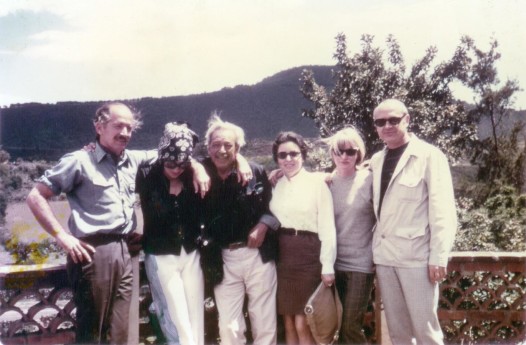
From left to right: George Dunbar, Jane Dunbar, Enrique Alférez, Shearly Grode, Peggy Alférez and Bob Helmer
In the summer of 1989, while waiting in line for a new passport at the Custom’s Office in New Orleans, I noticed a framed picture on the counter. I immediately recognized the subject. It was the famous sculptor, Enrique Alférez. The picture had been taken about forty years earlier, but he still looked the same. When it was my turn for a photo, I asked the officer why they had used his picture as a model. He said, “Mr. Alférez looks more like a man than any man I ever met.”
“True,” I said. “He’s also the reason I’m here…”
In the late 20th Century, just about every old Mexican claimed to have fought with Pancho Villa. But when PBS set out to make a documentary on the revolutionary hero, they had trouble finding anyone who actually had – until they met Senor Alférez. Enrique spent almost ten years riding with Villa. He used to tell me that to survive in the desert, they had to eat people. He said the knuckles were particularly tasty.
After his stint fighting along the border, Alférez moved to Chicago where he studied art and cleaned skyscraper windows. On his way back to the Yucatan, he stopped in New Orleans and, like so many others, never left.
Enrique and my father shared a studio in Gallier Hall and became fast friends. According to my dad, “If only half the stories were true, he’d still be the most interesting man I ever met.” Alférez married nine times, picked fights with people of “questionable character,” spent numerous nights behind bars and of course, even though he was colorblind, created some of the most endearing works of public art in the city of New Orleans.
Ricky was always working. Along with my dad, he was the most prolific artist I ever met. He was also very opinionated. Check out his duck, for Huey Long’s infamous deduct box at Charity Hospital, or his Latin American David on Poydras Street. He used to tell me, “You know Folwell, your (expletive) countrymen are sons of bitches (long pause with a scowl), but so are mine!”
A devout atheist, Ricky lived in a church on 8th Street. It was part of a compound that included a couple of houses, a tall cement wall with broken bottles embedded across the top, and a large courtyard with unfinished sculptures and avocado trees. Strangely, he had an almost identical compound down in Morelia. At least twice a year he and his last wife, Peggy would drive down to Mexico to cast sculptures and to escape the weather and madness of New Orleans. They would also smuggle pharmaceuticals to the local hospitals where there were frequent shortages of antibiotics.
In the winter of 1965, they asked my mom to join them. She imagined walking the beaches of Puerto Vallarta with Tennessee Williams or sipping mescal under the volcano with Malcolm Lowry. She immediately (and foolishly) said, “Yes!”
My mom was delicate like a flower. She was petit with pale green eyes and olive-colored skin. For her, “roughing it” was making groceries at Schwegmann or reading a magazine on the porch. She was definitely not cut out for transporting art and drugs across the Rio Grand.
Ricky and Peggy had an old Bronco and a beat-up trailer. Neither one was all that road worthy, especially for the roads of Mexico, which were at the time – it’s hard to believe – even worse than the streets of New Orleans. For almost two weeks they bounced over potholes and boulders, Aztec ruins and blue agave. There were countless breakdowns and flat tires, bribes to la policía y los bandidos, and painful bouts with a vengeful Montezuma.
Avoiding General John “Black Jack” Pershing with Pancho Villa would have been an easier feat! The trip was one endless Day of the Dead!
When they finally arrived in Morelia, my mom was a mere shadow of her former shadow-like self. She called my dad in tears. “I made a terrible mistake,” she cried. “I should never have come!”
“Sweetheart, everything will be o.k.,” my dad assured her. “I’m wiring money now for a flight to the capital. I’ll book us a room at the Gran Hotel Ciudad de Mexico on the Zocalo. I’ll see you there tonight…”
My parents hadn’t planned on having another child. Two was enough. Nonetheless, 9 months later, I was born.
It was a concepcion inmaculada – with a little help from the manly Mexican in the picture frame.
Folwell Dunbar is a local educator and artist. He was conceived in Mexico City. He can be reached at fldunbar@icloud.com
 NOLAbeings Multimedia artist Claire Bangser created NOLAbeings as a portrait-based story project that marries...
NOLAbeings Multimedia artist Claire Bangser created NOLAbeings as a portrait-based story project that marries...  Voodoo in New Orleans: Reviving history: New Orleans fortune telling This article takes a deep dive into the history of Voodoo in New Orleans, its hybridization with Catholicism, and its present-day place in the city's culture. The author visits fortune-tellers in the French Quarter, using their guidance as a tool for introspection rather than a deterministic predictor of the future. Through her experiences in New Orleans, the author feels a mystical connection to both the past and the future.
Voodoo in New Orleans: Reviving history: New Orleans fortune telling This article takes a deep dive into the history of Voodoo in New Orleans, its hybridization with Catholicism, and its present-day place in the city's culture. The author visits fortune-tellers in the French Quarter, using their guidance as a tool for introspection rather than a deterministic predictor of the future. Through her experiences in New Orleans, the author feels a mystical connection to both the past and the future. 